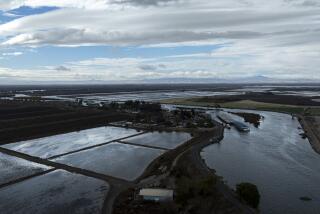DWP lawsuit over Owens Lake dust dismissed by federal judge
A federal court judge on Thursday dismissed a lawsuit filed by the Los Angeles Department of Water and Power against a state regulatory agency it claimed was forcing the city to waste billions of gallons of precious High Sierra water to control dust on dry Owens Lake.
In his 21-page ruling, U.S. District Court Judge Anthony W. Ishii determined that “there is no reason or logic” to key arguments in the DWP lawsuit, which was publicly supported by Mayor Antonio Villaraigosa, the Los Angeles City Council and the Los Angeles Chamber of Commerce.
The lawsuit filed in U.S. District Court in Fresno accused the Great Basin Unified Air Pollution Control District of issuing unreasonable and unlawful orders. It was prompted by Great Basin’s 2011 order that the city control dust on an additional 2.9 square miles of lake bed, a job that could cost ratepayers another $400 million.
The DWP argued that ratepayers have already spent $1.2 billion for vegetation, gravel and shallow flooding of Owens Lake that have reduced dust pollution by 90%.
It also argued that it is responsible for dust arising only from the roughly 42 square miles of the lake bed drained to provide water to the city. The utility said the State Lands Commission and the U.S. Bureau of Land Management should be responsible for the remaining 10 square miles of the area in their control.
Beyond that, the utility claimed it should not be liable for all the dust in a place surrounded by what it described as a “naturally dusty desert.”
Ishii, however, ruled that “ownership or management of the land underlying a pollution source is mostly irrelevant to question of liability.” More important, he ruled, “is the identity of the people or entities that have control over the activities that directly or indirectly caused the pollution.”
Beginning in 1905, Los Angeles began securing land and water rights in the Owens Valley. By 1913, the city had completed a 233-mile-long aqueduct from Owens Valley to the city, and began transferring water that had historically flowed into the lake.
The water transfers, Ishii said, “reduced the lake into a dry bed that is an abundant source of very fine particulate matter less than 10 microns in diameter that is readily blown into the air.”
Today, Owens Lake is the largest single source of particulate matter air pollution in the country. Particulate air emissions are a danger to human health and the environment; the particulates lodge deep in the lungs, causing respiratory injuries and additional risks to children and the elderly.
Over the last year, DWP’s water diversions have created dust storms that exceeded the federal standard on 25 separate days, resulting in the issuance of local health alerts.
ALSO:
O.C. supervisors poised to hire new CEO
Authorities search for man who shot at L.A. County deputies
Officers fire at teen armed with Tec-9 assault weapon, LAPD says
More to Read
Start your day right
Sign up for Essential California for news, features and recommendations from the L.A. Times and beyond in your inbox six days a week.
You may occasionally receive promotional content from the Los Angeles Times.







